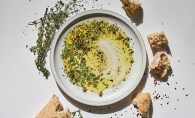They are two lovely Norwegian-American ladies, Marge Ellingson and Pam Olson. Both are members of Edina Morningside Community Church, who decided (“We were asked,” emphasizes Olson) to participate in a church-wide program called Morningside U, where participants share their talents with the community. Others before them had taught memoir writing and cartoon drawing. What was requested of Ellingson and Olson was a tutorial on how to make lefse, a soft Norwegian flatbread cooked on a griddle and made with potatoes, flour, butter and milk or cream.
“We planned for 25 or 30 [participants], and we got almost 100,” says Ellingson, admitting, “We didn’t know what we were getting into. They learned that several families were in attendance not so much for their own benefit but for that of their children. “Preserving heritage is important,” says Ellingson.
With three times the number of anticipated participants, “we split into two groups,” says Ellingson, which worked well, as she and Olson use slightly different lefse recipes. Everyone who wanted to got to try their hand at some element of lefse-making and had a sample to take home. Other traditional Norwegian sweets, like rosettes, krumkake and flatbread (crispier than lefse) were also on the roster. Ellingson says, “What people enjoyed most, it seems, was simply getting a little confidence with making traditional food.”
Surprisingly, neither Olson nor Ellingson reports having been taught lefse-making by their mothers. Ellingson grew up in Harmony, Minn., with lefse a common holiday treat but learned “more by osmosis” than formal instruction, she says. Olson learned how to make lefse as an adult from friends who hosted lefse-making parties, dinners rounded out with lutefisk, boiled potatoes, creamed peas, beets, pickles, and “always some kind of Scandinavian dessert,” says Olson. The first year Olson made lefse for her family she borrowed a lefse griddle (they can cost up to $100) on the day after Thanksgiving. “We still have a lefse-making day, every year on the Friday after Thanksgiving,” she says.
A recent photograph features Ellingson, her daughter, granddaughters and great-granddaughters, all making lefse and all wearing bright red aprons with the logo Familien Ellingson Skolen av Lefse, (Ellingson Family School of Lefse). Ellingson’s then 18-month-old great grandson, Olaf, had a lot of fun with the stick.
Speaking of the lefse stick, it’s used to turn the lefse on the griddle. How long does it take to cook on one side? You would think it was a state secret: no firm number of minutes is cited. “It depends on how thick it is,” advises Olson. “You don’t want it to burn, of course,” says Ellingson. A nicely mottled appearance is ideal, the ladies agree. As to how the lefse is served, the ladies also agree that it is generally folded in quarters when removed from the griddle, then cut and rolled to eat once cooled. Most people serve it with sugar. Olson offers a litany of accompaniments: brown sugar, butter, white sugar, cinnamon. Ellingson says, “Lefse is like a roll-up before roll-ups were popular,” adding that members of her family often roll meat into the lefse.
At the present time, both Ellingson’s and Olson’s children seem to prefer making lefse with their Norwegian matriarchs rather than making it alone. “Young people are so busy these days,” says Ellingson. And yet, hope springs eternal: Olson says that in spite of many lovely antiques she’d like to hand down to the next generation, “My daughter-in-law wants the lefse griddle.”
Lefse
From the recipe box of Geoline Morem, Marge Ellingson’s mother
Ingredients:
- 6 cups of boiled and riced potatoes
- 6 Tbsp. half-and-half (a little more than 1/3 cup)
- 5 Tbsp. butter, melted
- 1 heaping tsp. salt or to taste
- 2 heaping Tbsp. flour for each cup of potatoes (a little more than 1 cup). Use plenty of extra flour when rolling.
Equipment:
- Lefse griddle
- Lefse stick or turner
- Cloth-covered rolling pin
- Potato ricer
- Cloth-covered pastry board
Directions:
Boil (do not overcook) potatoes the night before. Put potatoes through a ricer. Let cool completely. Cover once cooled.
The next day, mix potatoes, half-and-half, butter and salt with a fork. Add flour and mix thoroughly with your hands until dough is the consistency of Play-doh.
Heat lefse griddle to 500 degrees. Shape dough into patties the size of an egg. Dust a cloth-covered pastry board with flour and place a patty in the center of the cloth. Dust a cloth-sleeved rolling pin and roll out patty to paper-thin. Lift the rolled dough with a lefse stick and place it onto the hot griddle. When bubbles begin to appear on the surface of the dough, turn it over using the lefse stick. Continue to cook until brown spots appear. Remove from griddle and place each piece of cooked lefse between flour-sack dishtowels to cool. (Dishtowels absorb moisture and prevent lefse from getting soggy while cooling.)
Makes approximately 13 medium-sized pieces. Once cooled, package and freeze if desired.
Lefse
From the recipe box of Pam Olson
Ingredients:
- 3 cups milk powder
- 9 cups hot water
- 3 sticks Blue Bonnet margarine
- 6 Tbsp. sugar
- 5 tsp. salt
- 9 cups potato buds
Directions:
Heat margarine and water to boiling. Add milk powder, sugar and salt. Mix thoroughly. Add potato buds and mix with an electric mixer. Place dough into a 9-by-13-inch covered plastic pan. Cool in the refrigerator overnight. Divide dough into thirds. Add 2 cups of flour to each third. Knead thoroughly and roll into balls. Roll out balls with a lefse rolling pin and fry on a griddle on each side until just before golden brown.









